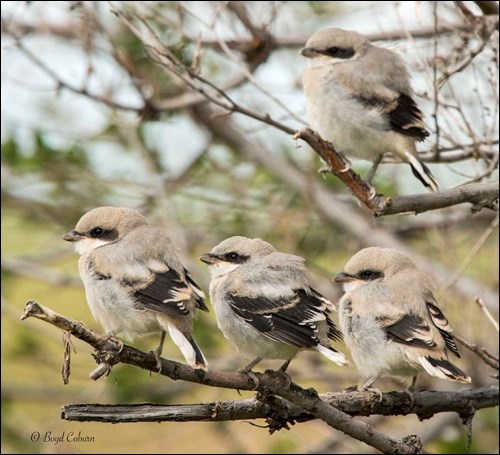“Young Loggerhead Shrikes (aka butcher birds) are out near their nests learning to perfect their hunting and impaling skills,” says Ashley Fortney, Habitat Stewardship co-ordinator with Nature Saskatchewan.
“This is the best time to observe shrikes and their graphic behaviours as the young may be in groups of four to seven, clumsily hunting and impaling prey in a localized area.”
Taking a lesson from butchers who hang their meat to dry, the Loggerhead Shrikes do the same with their food.
“These birds impale and hang their prey on barbed wire fences, thorny shrubs and broken branches, in order to effectively eat their oversized prey, affording them the nickname of ‘butcher bird,’” Fortney explains.
The shrike’s prey items include beetles and grasshoppers, but also larger prey such as snakes, mice, voles, frogs and even smaller songbirds. Similar to birds of prey these birds have sharp hooked beaks, however, unlike the birds of prey, shrikes lack strong talons, and must impale prey in order to tear pieces off during feeding.
The loggerhead shrike is slightly smaller than the American robin. Shrikes have a black mask that extends from the black bill past the eyes. These birds earn the “loggerhead” part of their name because they have relatively large heads compared to their bodies, and the “shrike” part of their name because they have a high pitched shriek for an alarm call. The loggerhead shrike has a grey back with white under parts, black wings and a black tail with characteristic white patches on the wings and stripes on the edges of the tail. These traits are easily seen when shrikes are in flight.
Loggerhead shrike chicks are the fuzzy fluff-ball equivalent to the parents. They have a similar black eye mask, although not as distinct, and a less smooth appearance when compared to their parents.
“My favourite feature about the chicks is their tail, which is very short and stubby compared to the length of the body,” says Fortney.
The chicks also have the same black and white marking on their wings. Around this time is when the young butchers-in-training are exploring the world around their nest.
The prairie population of loggerhead shrikes has seen declines of over 80 per cent in the past 35 years. Causes of decline are primarily habitat loss and degradation (e.g. removal of shelterbelts), as well as pesticide use and road mortality.
To learn more about the loggerhead shrike or to report a sighting please contact Nature Saskatchewan at 1-800-667-HOOT (4668). By reporting loggerhead shrike locations, you are providing valuable information used to assess population size and distribution in order to help direct the conservation efforts for this threatened bird. Information will not be shared without a landowner’s permission.




